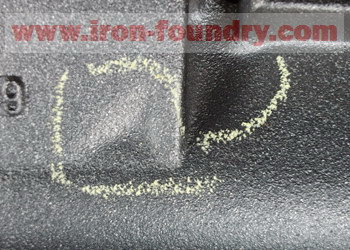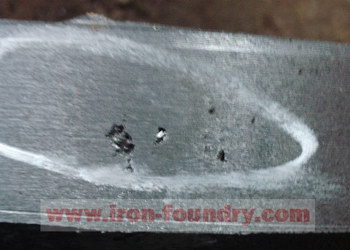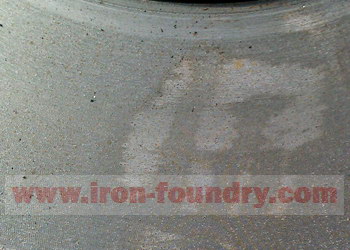| |
Cast Iron Shrinkage Defect
The cast iron shrinkage has very large
affect to the quality of iron castings.
It will reduce the tensile strength and elongation, so the iron
castings will be broken or penetrated at the shrinkage area.
According to my working experience in
Dandong Foundry in
China, there are three types of shrinkage.
1. sink on the surface
On the surface of rough castings, you could see the sunk pit. These
pits are caused by the shrinkage beneath the surfaces. Just like the
following photo. This kind of shrinkage will affect the dimensions
of this area, and affect its physical properties. Usually, this kind
of shrinkage is unacceptable.

2. large shrinkage holes
inside of cast iron
You can not see this shrinkage on the surfaces, but after machining,
it will be very obvious, you could see many small and large air
holes in the shrinkage area. Of course, this kind of shrinkage is
acceptable and very harmful to the application.

3. small shrinkage inside
of cast iron
Sometimes, after machining, you could see very fine air holes, or
sometimes, you can not see them by eyes, but can inspect them by
magnifying glass. Or, sometimes, you could fine them by water or oil
pressure testing. These shrinkage caused the low density to the
cast iron,
so they can not bear high pressure.

Obviously, the shrinkage is very harmful to
the iron castings. The main reason of shrinkage is the unreasonable
casting process, especially the gating sizes. After find the
shrinkage, the iron foundries should adjust their gating system.
However, since most of shrinkage defects are beneath the surfaces
of cast iron, how can we inspect them?
1. Normally, you could allow your supplier to do the rough
machining, so they will find the shrinkage after their machining.
This method is the most obvious and economic method since most of
iron foundries in China have
the rough machining capability in-house.
2. As for the
pump bodies or
valve bodies, you could do
the water pressure test or ask your supplier to random test them.
Although this method can not guarantee all castings are qualified,
at least, it can affect some problems.
3. You could cut off the sensitive
positions to check the shrinkage. According to our experiences, the
shrinkage usually happen at the pouring gate area and some corner
areas. So, after you find the shrinkage positions, you could inspect
these positions in your batch inspection. You could just cut off
these positions by sawing machine or require the supplier to cut off
these positions with potential shrinkage according to your
instruction.
Home |
More Articles |
|
